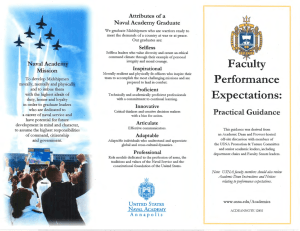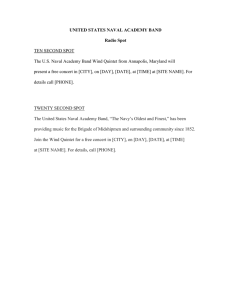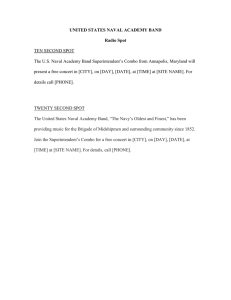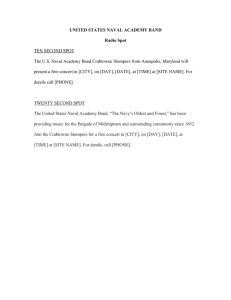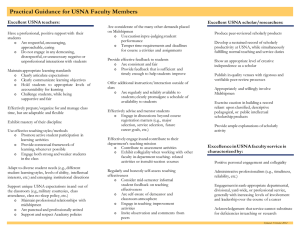Profile of the Month LCDR Mark Z. Zielinski
advertisement
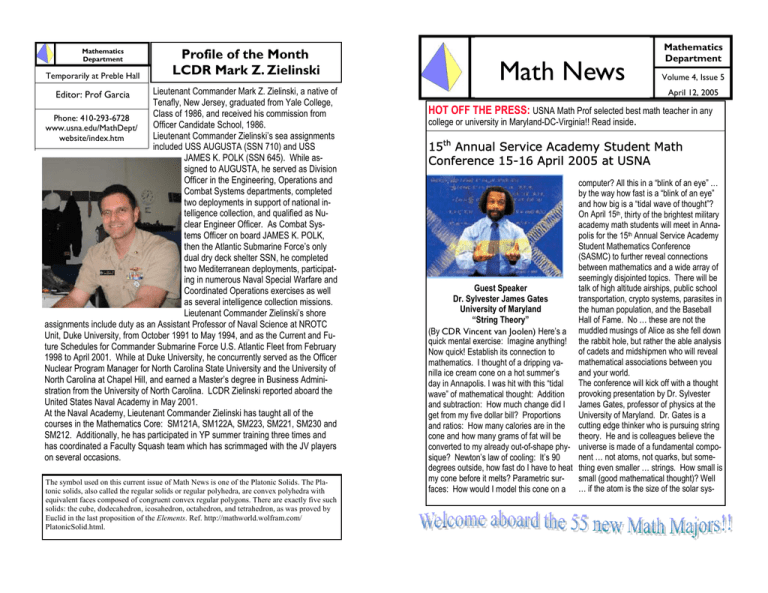
Mathematics Department Temporarily at at Preble Preble Hall Hall Temporarily Profile of the Month LCDR Mark Z. Zielinski Lieutenant Commander Mark Z. Zielinski, a native of Tenafly, New Jersey, graduated from Yale College, Class of 1986, and received his commission from Phone: 410-293-6728 Officer Candidate School, 1986. www.usna.edu/MathDept/ Lieutenant Commander Zielinski’s sea assignments website/index.htm included USS AUGUSTA (SSN 710) and USS JAMES K. POLK (SSN 645). While assigned to AUGUSTA, he served as Division Officer in the Engineering, Operations and Combat Systems departments, completed Organization two deployments in support of national intelligence collection, and qualified as Nuclear Engineer Officer. As Combat Systems Officer on board JAMES K. POLK, We’re on the Web! then the Atlantic Submarine Force’s only example. dual dry deck shelter SSN, he completed microsoft.com two Mediterranean deployments, participating in numerous Naval Special Warfare and Coordinated Operations exercises as well as several intelligence collection missions. Lieutenant Commander Zielinski’s shore assignments include duty as an Assistant Professor of Naval Science at NROTC Unit, Duke University, from October 1991 to May 1994, and as the Current and Future Schedules for Commander Submarine Force U.S. Atlantic Fleet from February 1998 to April 2001. While at Duke University, he concurrently served as the Officer Nuclear Program Manager for North Carolina State University and the University of North Carolina at Chapel Hill, and earned a Master’s degree in Business Administration from the University of North Carolina. LCDR Zielinski reported aboard the United States Naval Academy in May 2001. At the Naval Academy, Lieutenant Commander Zielinski has taught all of the courses in the Mathematics Core: SM121A, SM122A, SM223, SM221, SM230 and SM212. Additionally, he has participated in YP summer training three times and has coordinated a Faculty Squash team which has scrimmaged with the JV players on several occasions. Math News Volume 4, Issue 5 April 12, 2005 Editor: Prof Garcia The symbol used on this current issue of Math News is one of the Platonic Solids. The Platonic solids, also called the regular solids or regular polyhedra, are convex polyhedra with equivalent faces composed of congruent convex regular polygons. There are exactly five such solids: the cube, dodecahedron, icosahedron, octahedron, and tetrahedron, as was proved by Euclid in the last proposition of the Elements. Ref. http://mathworld.wolfram.com/ PlatonicSolid.html. Mathematics Department HOT OFF THE PRESS: USNA Math Prof selected best math teacher in any college or university in Maryland-DC-Virginia!! Read inside. 15th Annual Service Academy Student Math Conference 15-16 April 2005 at USNA computer? All this in a “blink of an eye” … by the way how fast is a “blink of an eye” and how big is a “tidal wave of thought”? On April 15th, thirty of the brightest military academy math students will meet in Annapolis for the 15th Annual Service Academy Student Mathematics Conference (SASMC) to further reveal connections between mathematics and a wide array of seemingly disjointed topics. There will be Guest Speaker talk of high altitude airships, public school Dr. Sylvester James Gates transportation, crypto systems, parasites in University of Maryland the human population, and the Baseball “String Theory” Hall of Fame. No … these are not the (By CDR Vincent van Joolen) Here’s a muddled musings of Alice as she fell down quick mental exercise: Imagine anything! the rabbit hole, but rather the able analysis of cadets and midshipmen who will reveal Now quick! Establish its connection to mathematical associations between you mathematics. I thought of a dripping vaand your world. nilla ice cream cone on a hot summer’s The conference will kick off with a thought day in Annapolis. I was hit with this “tidal wave” of mathematical thought: Addition provoking presentation by Dr. Sylvester and subtraction: How much change did I James Gates, professor of physics at the University of Maryland. Dr. Gates is a get from my five dollar bill? Proportions and ratios: How many calories are in the cutting edge thinker who is pursuing string theory. He and is colleagues believe the cone and how many grams of fat will be converted to my already out-of-shape phy- universe is made of a fundamental component … not atoms, not quarks, but somesique? Newton’s law of cooling: It’s 90 degrees outside, how fast do I have to heat thing even smaller … strings. How small is small (good mathematical thought)? Well my cone before it melts? Parametric surfaces: How would I model this cone on a … if the atom is the size of the solar sys- Math News Page 2 Volume 4, Issue 5 Page 3 15th Annual Service Academy Student Mathematics Conference (Cont.) 15th Annual Service Academy Student Mathematics Conference (Cont.) tem, a string is the size of a tree on the earth. Wow! That is small! But wait, it gets deeper. In order for string theory to work, the universe must exist in eleven dimensions!! Egad, talk about your multi-variable calculus! Here’s the final conundrum … we cannot measure strings, we cannot see them under even the most powerful of electron microscopes, and we cannot observe their effects. In other words, the theory exists in a mathematics sense only, and has not yet manifested itself in physically realities. This faith in mathematics to unlock the not yet obvious properties of the universe around you is not without precedent. Einstein’s theory of relatively was not verified by physical measurements until 40 years after he published his radical thoughts. One might conclude from all this that advances in universal truths are preceded by breakthroughs in advanced mathematics. If Dr. Gates is successful he will bring us one step closer to the elusive “theory of everything”. On the second day of the conference, over thirty midshipmen and cadet math majors will try their hand at reporting their observations of the real world in a concrete mathematical framework. A year’s worth of hard work will culminate in a 20 minute presentation. No more and no less. Their audiences will then decide the strength of their mathematical conclusions. The presentation itself is not only an opportunity to exchange ideas, but it and hopefully present and or publish your findings to others. Perhaps you will be the source of the next revolution in thought. The talk by Dr. Gates will be given on Friday, 15 April at 1800 in Rickover 102. Midshipmen who wish to attend must email CDR van Joolen (vanjoole@usna.edu). You will be included on an excusal from the evening is, in essence, a sales pitch. The conference environment is a clearing house for new thoughts and research. Much of what is presented will not go much further, but if the mathematical conclusions are strong and convincing, the ideas gain prominence. Publications, invitations to conferences around the world, and perhaps fame or notoriety follow. In the end, the grandest of new ideas change our world forever. SASMC was conceived in 1990 to provide a venue for midshipmen and cadets to present their honors research. Each year a service academy and occasionally the Naval Postgraduate School in Monterey hosts the event. USNA last played host in 2002 when today’s First Class Midshipmen were plebes. For most this will be their first opportunity to make a conference presentation. This year’s Second Class will have the opportunity to travel to Colorado Springs next year to present at the 16th SASMC at the US Air Force Academy. All math majors are encouraged to attend, as many of you will be pitching your ideas in years to come. As your military career progresses you will be afforded opportunities to continue your education, provided a significant amount of time to perform research, meal and be provided pizza after the talk. All midshipmen are welcome to attend the student presentations which will be held on Saturday on the first floor of Michelson from 0800 to 1400. Who knows, maybe an idea will be born here that radically changes the way in which we view our world. Schedule of Events Friday 15 April 1800 (Rickover 102) Guest Speaker – Dr. Sylvester James Gates Saturday 16 April 0800-1400 (Michelson 107, 112, 115, 116) Student Presentations by Honors Math Students from the Service Academies. HOT OFF THE PRESS: Professor George Nakos of the USNA Math Department has been selected to receive the annual award by the Mathematical Association of America as the best math teacher in any college or university in the Maryland-DC-Virginia region! He will automatically become this region's nominee for the annual award to the best math teacher in the U.S.! Answers for last issue puzzles: The answer for last issue’s question is 3 pennies. After the second penny, they would have either two yellow or two blue jawbreakers, or a yellow and a blue jawbreaker. In the last case a third penny would deliver a jawbreaker that had to match one of the colors. Last issue’s winner was MIDN 3/C Sophia J Fischer. Question of the Month In 24 hours, how many times does the long hand of the clock pass the short hand? Pass means that one hand follows, overtakes and goes past the other. US Naval Academy Annapolis, MD US Military Academy, West Point, NY US Air Force Academy, Colorado Springs, CO US Coast Guard Academy, New London, CT E-mail your answer to Prof. Garcia, smg@usna.edu. Among those with the right answer, a randomly chosen midshipman will get a fantastic math water bottle.

